The Economics and Statistics Division maintains archives of previous publications for accountability purposes, but makes no updates to keep these documents current with the latest data revisions from Statistics Canada. As a result, information in older documents may not be accurate. Please exercise caution when referring to older documents. For the latest information and historical data, please contact the individual listed to the right.
<--- Return to Archive
For additional information relating to this article, please contact:
October 06, 2017US EMPLOYMENT, SEPTEMBER 2017 US non-farm employment declined 33,000 in September 2017.
This is the first monthly decline reported in US employment since 2010, however, the Bureau of Labor Statistics notes that three major hurricanes in late August and early September affected results of the Current Employment Statistics of business establishments as well as the Current Population Survey of households.
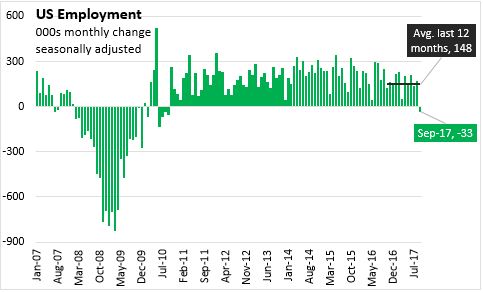
Impacts of hurricanes on US employment data
The Current Employment Statistics survey contacts business establishments to assess their payroll employment as of the 12th of the month. On that day, areas of Florida, Texas, Puerto Rico and the US Virgin Islands had experienced catastrophic damage from Hurricanes Irma and and Harvey (the impacts of Hurricane Maria followed later in the month). Data collection in the affected areas was impaired by the effects of these storms.
In the establishment survey, an employee is only counted when they are paid during the period that includes the 12th day of the month. In the case of the storm-affected areas, those establishments that were shuttered or destroyed by the storms and paid no staff during this time would report zero employment. This explains the anomalous result for the September non-farm payroll employment (-33,000).
In the household survey, an individual is still counted as 'employed' even if they have no work or limited hours because of bad weather. The Current Population Survey specifically asks about the impact of bad weather on employment, but such impacts are more common during winter storms than in hurricane season. Households in the US reported that there were 2.93 million people who were normally employed full time, but only worked part time hours during the September reference week because of bad weather. This is the highest such impact reported during the hurricane season since September 1999. A further 1.47 million American workers reported that they had no work at all because of bad weather. This is the highest level of weather-related work absence in any hurricane season since 1976 and the second highest for any month except January 1996.
The differences between these two surveys help to explain why US labor force and employment rates rose and the unemployment rate fell while payroll employment was down. Weather-affected workers surveyed at the household level were counted as employed and part of the labour force. Those measured at the establishment level (which is used as the primary indicator of US employment growth) were not counted as employed.
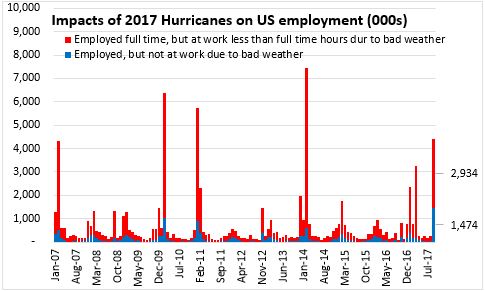
Employment in food services and drinking places was down an unusually large amount (105,000) due to the effects of hurricane. Health care employment increased by 23,000 while transportation sectors added 22,000 jobs. There were smaller employment gains in finance (10,000) and professional/business services (13,000) and virtually no change in manufacturing, wholesale, retail, construction, information services and government.
The US unemployment rate fell to 4.2 per cent in September's household survey. Comparing the US with Canada and Nova Scotia, the provincial unemployment rate for September was 9.0 per cent while Canada's was 6.2 per cent. Although monthly unemployment rates are more variable in Nova Scotia (smaller sample size) the long run average of NS unemployment rates is typically higher than the US, except during the 2009 recession.
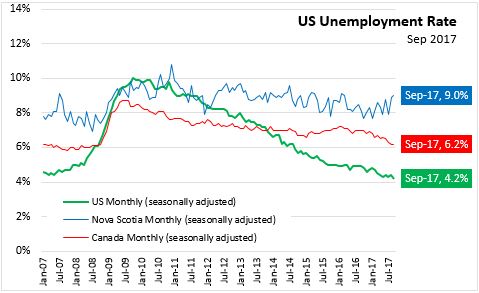
The US employment rate increased to 60.4 per cent in September, continuing on an upward trend observed since 2014. This is higher than the NS September employment rate of 56.3 per cent, which has experienced some months of volatility over the last 12 months. Canada's national employment rate from the middle of 2016 to mid 2017, but has been stable at 61.6 per cent for the last four months.
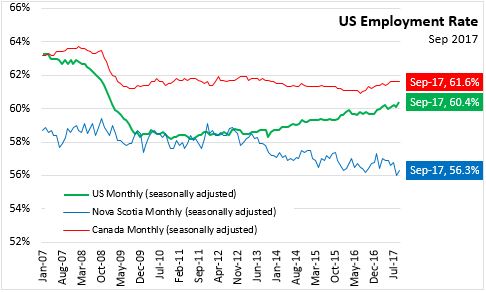
The US participation rate was up in September to 63.1 per cent, with the civilian labour force up by 575,000. The NS participation rate in the labour force has been volatile in recent months, rising to to 61.9 per cent in September. Canada's labour force participation rates have been stable at just under 66 per cent since 2015, but they have lately edged down to 65.6 per cent as of September.
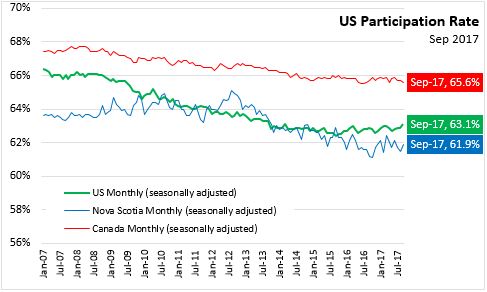
Note: NS and US labour force statistics refer to different working-age cohorts.
Source: US Bureau of Labor Statistics, Statistics Canada CANSIM table 282-0087
<--- Return to Archive